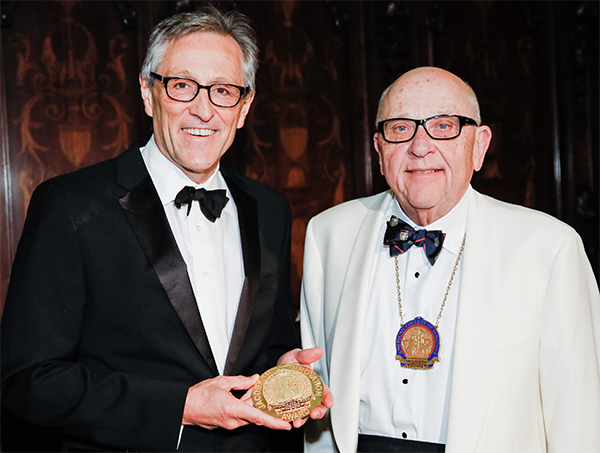Vascular Surgeon Tim Chuter Honored with 2017 Jacobson Innovation Award
Timothy A.M. Chuter, BM BS, DM, FACS, Professor of Surgery in the Division of Vascular and Endovascular Surgery, has been honored with the 2017 Jacobson Innovation Award by the American College of Surgeons (ACS) for his pioneering work, spanning many decades, in the field of endovascular aneurysm repair. Dr. Chuter received the award, which honors living surgeons who have been innovators of a new development or technique in any field of surgery, at a dinner held in his honor by the ACS on June 9 in Chicago. The award is made possible through a gift from Julius H. Jacobson II, MD, FACS, a general vascular surgeon known for his pioneering work in the development of microsurgery, and his wife Joan.
Dr. Chuter, a Fellow of the American College of Surgeons (FACS), was honored with this international surgical award in recognition of his innovations in the field of endovascular aneurysm repair. He was the first to design, develop, and implant bifurcated stent grafts as a treatment for abdominal aortic aneurysms. The ACS, described the approach, a hallmark of Dr. Chuter's inventions, as embodying a very simple principle:
If the aneurysm has branches–as it does at the bifurcation of the common iliac artery, the bifurcation of the aorta, the arch of the aorta, and the thoracoabdominal aorta–the endovascular prosthesis should also have branches. Because the most common site for aortic aneurysm involves the distal abdominal aorta, bifurcated endovascular repair has become the most accepted method of aneurysm repair worldwide.
Importantly, Dr. Chuter's devices and surgical techniques made aneurysm repair possible in patients who might otherwise have had no effective treatment options.

Dr. Courtney M. Townsend, Jr. (right), President of the American College of Surgeons, presents Dr. Timothy A.M. Chuter (left) with the 2017 Jacobson Innovation Award
Between 1993 and 2000, there was rapid expansion in the scope of endovascular aneurysm repair including the first endovascular repair of a ruptured aortic aneurysm (1994), the first endovascular repair of an aortobronchial fistula (1995), the first bifurcated stent grafts (1993), the first inflammatory aneurysms (1995), the first fenestrated stent grafts for aneurysms of the pararenal aorta (1998), and the first branched stent grafts for the thoracoabdominal aorta (2000). Although none was the work of a single inventor, Dr. Chuter’s trailblazing work was pivotal in this rarefied period of surgical breakthroughs, not simply by his invention of new forms of endovascular aneurysm repair, but also through his mentoring of surgical residents, fellows, and faculty.
Notably, Dr. Chuter has nurtured his inventions from conceptualization to life-saving therapeutic interventions. In addition to pioneering the minimally invasive approaches to endovascular aneurysm repair, he invented and patented the very stent grafts that are utilized in the surgery.
Dr. Chuter has been recognized for his work in the field throughout his career: by the Royal College of Surgeons (Kinmonth Medal, 1995), the Society for Vascular Surgery (Medal for Innovation in Vascular Surgery, 2008) and the Society for Endovascular Therapy (2009). Dr. Chuter holds more than 40 patents, including 23 related to endovascular aortic stent-graft devices, stents, attachment systems, delivery systems, and component junctions.
